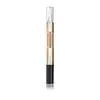What's inside
What's inside
 Key Ingredients
Key Ingredients

 Benefits
Benefits

 Concerns
Concerns

 Ingredients Side-by-side
Ingredients Side-by-side

Water
Skin ConditioningCyclopentasiloxane
EmollientTalc
AbrasiveGlycerin
HumectantDimethicone
EmollientParaffin
PerfumingPropylene Glycol
HumectantPEG/PPG-18/18 Dimethicone
EmulsifyingSodium Chloride
MaskingCI 77163
Cosmetic Colorant1,2-Hexanediol
Skin ConditioningCaprylyl Glycol
EmollientDimethicone Crosspolymer
Emulsion StabilisingDimethiconol
EmollientEthylene/Propylene Copolymer
AbrasiveMethicone
EmollientMicrocrystalline Wax
Emulsion StabilisingPhenoxyethanol
PreservativePolyethylene
AbrasiveSodium Benzoate
MaskingSynthetic Wax
AbrasiveIron Oxides
CI 77891
Cosmetic ColorantMica
Cosmetic ColorantWater, Cyclopentasiloxane, Talc, Glycerin, Dimethicone, Paraffin, Propylene Glycol, PEG/PPG-18/18 Dimethicone, Sodium Chloride, CI 77163, 1,2-Hexanediol, Caprylyl Glycol, Dimethicone Crosspolymer, Dimethiconol, Ethylene/Propylene Copolymer, Methicone, Microcrystalline Wax, Phenoxyethanol, Polyethylene, Sodium Benzoate, Synthetic Wax, Iron Oxides, CI 77891, Mica
Water
Skin ConditioningCyclopentasiloxane
EmollientTitanium Dioxide
Cosmetic ColorantPropylene Glycol
HumectantDimethicone
EmollientTalc
AbrasiveAluminum Starch Octenylsuccinate
AbsorbentPEG/PPG-18/18 Dimethicone
EmulsifyingSodium Chloride
MaskingPvp
Emulsion StabilisingLaureth-7
EmulsifyingTrihydroxystearin
Skin ConditioningMethicone
EmollientHydrogenated Soybean Oil
EmollientParaffin
PerfumingPolyglyceryl-4 Isostearate
EmulsifyingCetyl PEG/PPG-10/1 Dimethicone
EmulsifyingHexyl Laurate
EmollientSilica
AbrasiveStearic Acid
CleansingEthylene/Methacrylate Copolymer
Synthetic Wax
AbrasiveCera Microcristallina
Emulsion StabilisingPolyethylene
AbrasiveAluminum Hydroxide
EmollientSodium Dehydroacetate
PreservativePropylparaben
PreservativeMethylparaben
PreservativeEthylene Brassylate
MaskingCI 77492
Cosmetic ColorantCI 77491
Cosmetic ColorantCI 77499
Cosmetic ColorantWater, Cyclopentasiloxane, Titanium Dioxide, Propylene Glycol, Dimethicone, Talc, Aluminum Starch Octenylsuccinate, PEG/PPG-18/18 Dimethicone, Sodium Chloride, Pvp, Laureth-7, Trihydroxystearin, Methicone, Hydrogenated Soybean Oil, Paraffin, Polyglyceryl-4 Isostearate, Cetyl PEG/PPG-10/1 Dimethicone, Hexyl Laurate, Silica, Stearic Acid, Ethylene/Methacrylate Copolymer, Synthetic Wax, Cera Microcristallina, Polyethylene, Aluminum Hydroxide, Sodium Dehydroacetate, Propylparaben, Methylparaben, Ethylene Brassylate, CI 77492, CI 77491, CI 77499
Ingredients Explained
These ingredients are found in both products.
Ingredients higher up in an ingredient list are typically present in a larger amount.
Cyclopentasiloxane, or D5, is a silicone used to improve texture of products and trap moisture.
D5 is considered lightweight and volatile. Volatile means it evaporates quickly after application. Once evaporated, D5 leaves a thin barrier that helps keep skin hydrated.
It is also an emollient. Emollients help soften the skin and prevent water loss. Silicones create a silky texture in products. D5 helps other ingredients become more spreadable.
Studies show D5 is safe to use in skincare products. We recommend speaking with a skincare professional if you have concerns.
Learn more about CyclopentasiloxaneDimethicone is a type of synthetic silicone created from natural materials such as quartz.
What it does:
Dimethicone comes in different viscosities:
Depending on the viscosity, dimethicone has different properties.
Ingredients lists don't always show which type is used, so we recommend reaching out to the brand if you have questions about the viscosity.
This ingredient is unlikely to cause irritation because it does not get absorbed into skin. However, people with silicone allergies should be careful about using this ingredient.
Note: Dimethicone may contribute to pilling. This is because it is not oil or water soluble, so pilling may occur when layered with products. When mixed with heavy oils in a formula, the outcome is also quite greasy.
Learn more about DimethiconeMethicone is a type of silicone and is a simpler form of dimethicone.
Silicones are used to enhance the texture of products and have emollient properties. Methicone is used to give products a silky texture and improves spreadability.
Paraffin is a solid created from petroleum. The term 'paraffin' can also refer to either
petroleum jelly or mineral oil.
It has natural occlusive properties which can worsen oily skin. Due to its petrolatum base, this ingredient is not fungal-acne safe.
PEG/PPG-18/18 Dimethicone is a type of silicone.
Polyethylene is a synthetic ingredient that helps the skin retain moisture. It is a polymer.
It is also typically used within product formulations to help bind solid ingredients together and thicken oil-based ingredients. When added to balms and emulsions, it helps increase the melting point temperature.
Propylene Glycol is an odorless, colorless liquid. As a humectant, it helps skin retain moisture. It also aids in delivering active ingredients.
Another role of this ingredient is preventing a product from melting or freezing. Propylene glycol also adds antimicrobrial properties to a product, elongating product lifespan.
This ingredient is considered an organic alcohol and commonly added into both cosmetics and foods.
Those with sensitive skin or conditions may develop a rash when using this ingredient.
Learn more about Propylene GlycolChances are, you eat sodium chloride every day. Sodium Chloride is also known as table salt.
This ingredient has many purposes in skincare: thickener, emulsifier, and exfoliator.
You'll most likely find this ingredient in cleansers where it is used to create a gel-like texture. As an emulsifier, it also prevents ingredients from separating.
There is much debate on whether this ingredient is comedogenic. The short answer - comedogenic ratings don't tell the whole story. Learn more about comegodenic ratings here.
The concensus about this ingredient causing acne seems to be divided. Research is needed to understand if this ingredient does cause acne.
Scrubs may use salt as the primary exfoliating ingredient.
Learn more about Sodium ChlorideSynthetic Wax is created from fossil fuels such as natural gas. It is used to enhance texture, adjust pH, and as an occlusive.
It may also be used as an abrasive ingredient to exfoliate the skin.
Synthetic Wax may not be fungal acne safe.
Learn more about Synthetic WaxTalc is a clay mineral. It helps absorb moisture and improve the texture of products. Like other types of clay, Talc can have a slight exfoliating effect on skin. Talc can be added to increase the volume of products.
Some Baby powders are made by combining talc with corn starch. The word "talc" comes from Latin and originates from Arabic. Talc is a mineral commonly found throughout the world.
If you have any concerns about using talc, we recommend checking out the FDA's official page.
Learn more about TalcWater. It's the most common cosmetic ingredient of all. You'll usually see it at the top of ingredient lists, meaning that it makes up the largest part of the product.
So why is it so popular? Water most often acts as a solvent - this means that it helps dissolve other ingredients into the formulation.
You'll also recognize water as that liquid we all need to stay alive. If you see this, drink a glass of water. Stay hydrated!
Learn more about Water